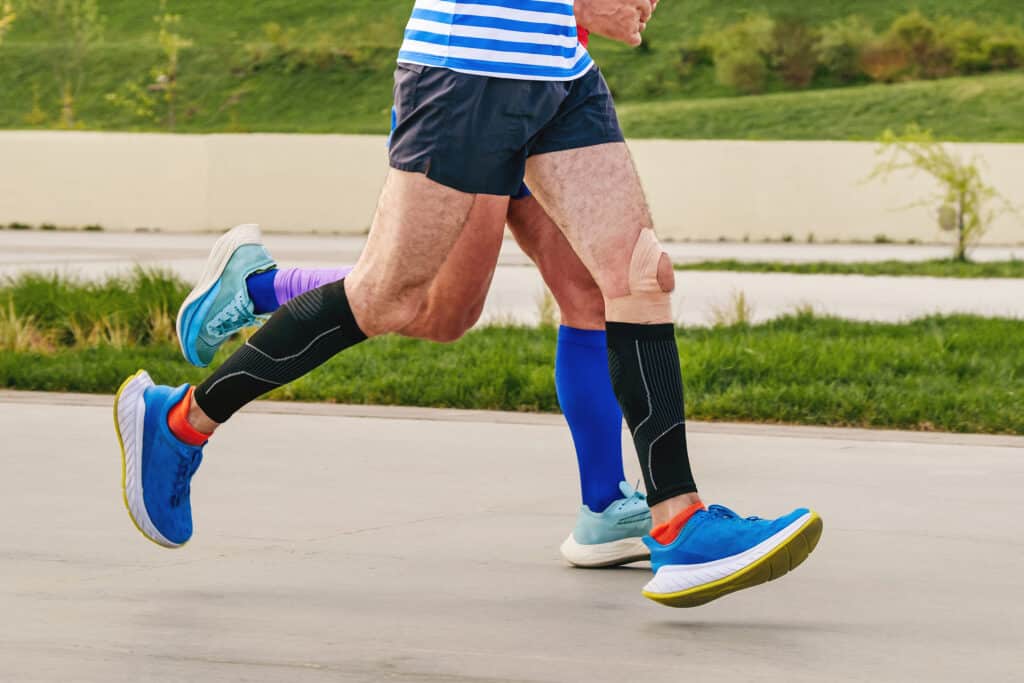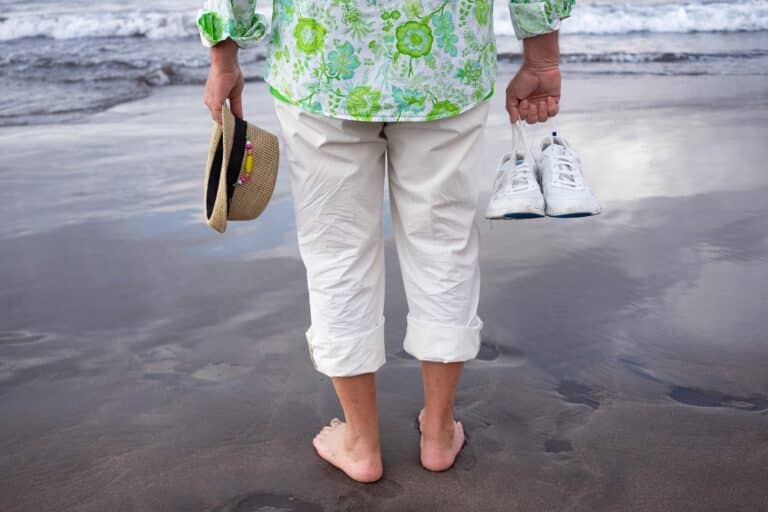Has your doctor recently recommended compression socks to help remedy circulation problems? If so, you’re not alone. Poor circulation is a common complaint for many older adults, particularly in the legs, often leading to discomfort and health risks.
Compression socks are a proven tool to help in this all-too-common scenario. These unique socks aid circulation, ease leg pain, and reduce swelling.
No longer just for severe medical conditions or extended hospital stays, compression socks can be a daily tool for healthier living. As a physical therapist who has worked with every type of compression sock on the market today, I want to help you understand how to get the most out of your compression socks and improve your leg health.
This article is your comprehensive guide to compression socks, including how they work, what they are for, and why they might be the missing tool in your health routine toolkit.
What Are Compression Socks?
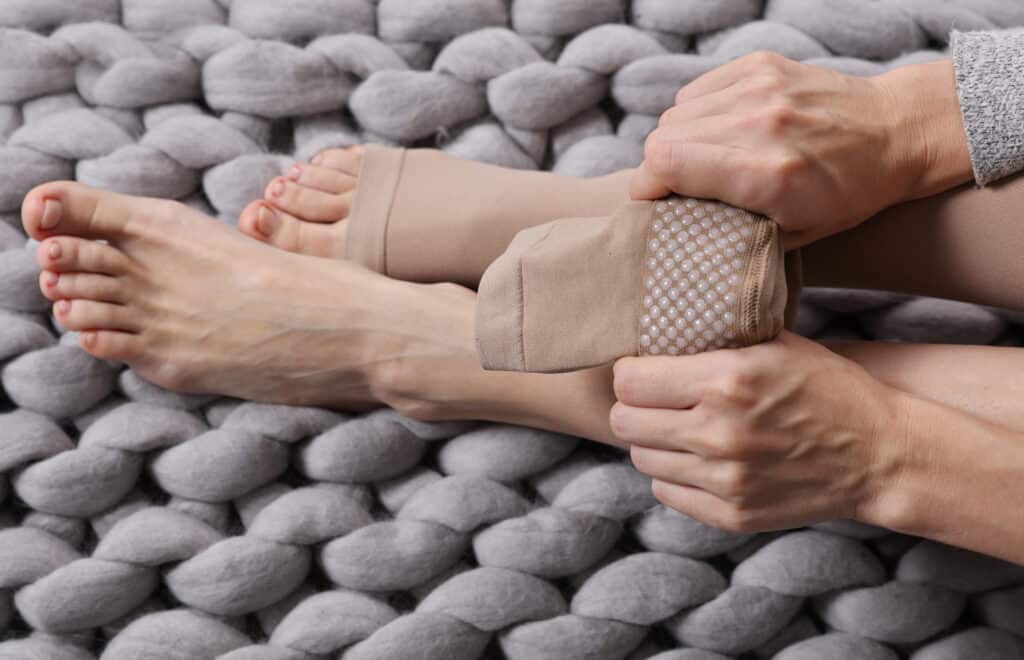
So, what exactly are compression socks?
In short, compression socks are specialized socks designed to fit your legs snuggly. But they’re more than just a tight pair of socks; they’re an essential piece of wellness equipment for your leg health.
Compression socks function by applying gentle pressure to your legs and ankles. This pressure promotes blood flow from your legs to your heart, reducing swelling and discomfort.1
You might be wondering how a pair of socks could have such a significant impact on your health. The answer lies in the design and material used in these socks, which usually involves a high-elasticity fabric that fits snugly at your feet and gradually loosens along your leg. This creates a pressure gradient that helps circulation, encouraging blood flow toward your heart.
I’ve worked with many older adults who wear compression socks for various reasons. What matters most is getting the right pair for your needs, ensuring they fit correctly, and keeping an open line of communication with your healthcare provider on how you respond to them.
The Benefits of Wearing Compression Socks
While the main benefit of compression socks is improved circulation, there are other benefits to using compression socks when recommended.
Reducing Swelling
Compression socks can help reduce swelling, especially in the lower legs and ankles. This is particularly beneficial for those who spend long hours standing or sitting, as these positions can cause blood to pool in the leg veins, leading to swelling and discomfort.
Preventing Blood Clots
Compression socks can help prevent deep vein thrombosis (DVT). In this potentially dangerous condition, blood clots form in the body’s deep veins, usually in the leg.2
Your doctor can tell you if you need compression socks for this specific condition, and it is discussed more thoroughly in the next section.
Alleviating Pain
Compression socks can help alleviate pain and discomfort by improving circulation for those suffering from varicose or spider veins.
Other Common Conditions
Varieties of compression socks are available for many issues, each designed for different purposes and populations.
For instance, knee-high and thigh-high compression socks are often recommended for those with circulation problems. Meanwhile, maternity compression socks are designed for pregnant women experiencing swollen feet and ankles.3
Most patients I work with wear compression socks to help prevent swelling during their day, not due to a diagnosed medical condition. However, I have also worked with many patients who need to use their compression socks as their doctor prescribes to prevent medical complications from conditions that affect circulation.
For this reason, you’ll always want to talk to your healthcare provider about what type of compression is best for you rather than going for the same type your friends or family have.
Conditions That Benefit From Compression Socks

While most older adults don’t need compression socks to maintain their health and wellness, they can be essential equipment for others. Let’s dive into the specific conditions that may call for compression socks.
Circulation Problems
Older adults with circulation problems such as venous insufficiency, varicose veins, or venous ulcers can find relief using compression socks.
Venous insufficiency
This is a condition where the veins have difficulty sending blood from the legs back to the heart, and varicose veins or venous ulcers can result from this problem. Compression socks can help by applying pressure to the leg, aiding blood flow.
Deep Vein Thrombosis (DVT) or Post-Thrombotic Syndrome
People who’ve had a deep vein thrombosis (DVT) or post-thrombotic syndrome can also benefit. DVT is a blood clot in a deep vein, usually in the leg, that can result from injury or blood pooling.
Compression socks can reduce the risk of DVT by improving circulation, which helps prevent blood from pooling and clotting.
Lymphedema or Edema
Lymphedema or edema are conditions characterized by leg swelling due to fluid buildup. While edema is temporary, lymphedema occurs due to chronic problems with lymphatic circulation and can last a lifetime.
Both conditions can be managed with the help of compression socks, as the pressure from the socks helps move fluid away from the affected area to reduce swelling.4
Orthostatic Hypotension
Have you ever felt lightheaded or dizzy when standing or sitting up too fast? This is called orthostatic hypotension, and it happens often in older adults. It is caused by the temporary drop in blood pressure going to the brain due to the delay in blood returning from the legs to the brain against gravity.
Those who experience orthostatic hypotension, a form of low blood pressure that happens when you stand up from sitting or lying down, may also find compression socks helpful.
Compression socks can help push blood up from the legs, reducing the effects of low blood pressure during position changes. While this use of compression socks isn’t entirely supported by research, it may be valuable for certain people depending on the advice of their healthcare team.5
Diabetic Neuropathy
Older adults living with diabetic neuropathy may also see benefits from using compression socks. Diabetic neuropathy is a type of nerve damage that can occur if you have diabetes, most often affecting the legs and feet to cause weakness, numbness, and pain.
Compression socks can help improve circulation, reducing the uncomfortable symptoms associated with this condition. However, those with diabetes need to consult with their healthcare provider before starting any new treatment, including compression socks, as they can sometimes exacerbate certain complications of the disease.
When I work with older adults with diabetic neuropathy, skin care is one of the most important topics we focus on. When you have less sensation in your feet, it’s harder to tell when the skin of your feet is injured or when your feet are under too much pressure.
This makes it especially important to regularly check your feet when using compression socks and talk to your doctor about any changes in your condition.
Other Common Situations That May Benefit From Compression Socks
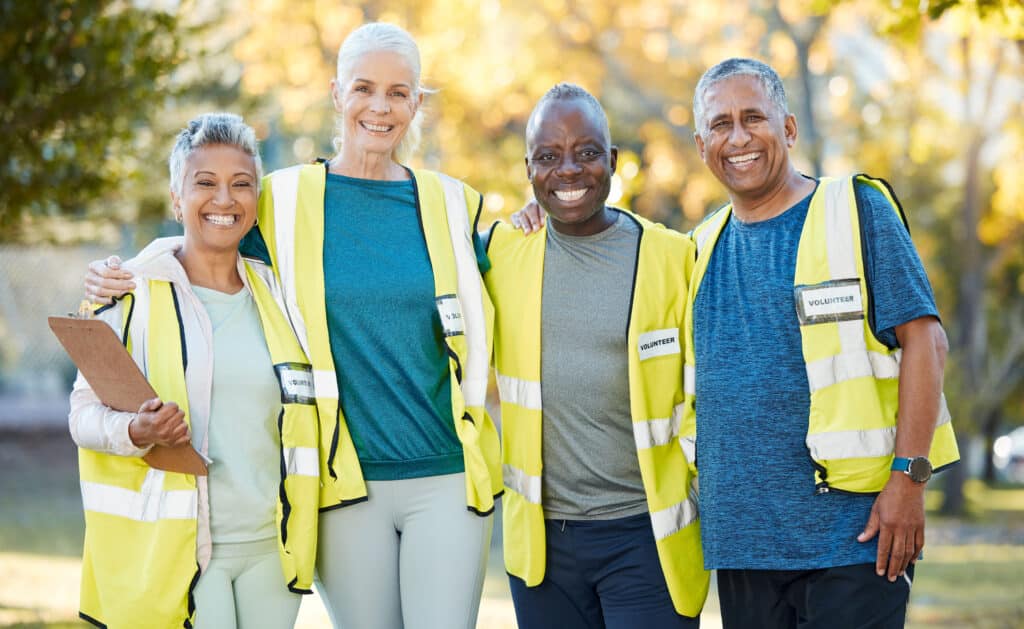
Now that we’ve covered common medical conditions for which compression socks are used, let’s look at some of the most common lifestyle situations that may benefit from using compression socks.
Long Periods of Sitting or Standing
Do you travel frequently or have a job that requires long periods of sitting or standing? Compression socks can be your legs’ best friend.
Compression socks help improve circulation, which reduces fluid buildup in your legs and, in some cases, can lower the risk of blood clot formation associated with prolonged immobility (staying in one place).
This is the most common situation in which my patients who don’t have a specific medical need for compression socks will use them. Many older adults work or volunteer in situations that require long periods of sitting or standing, and taking every precaution to avoid swelling can help.
Of course, movement and exercise are often the best ways to prevent leg swelling for otherwise healthy older adults, so make time to move your legs and exercise as frequently as you can!
Athletic Performance and Recovery
Athletes and active older adults can also benefit from using compression socks. Even the slightest amount of swelling can lead to discomfort while hiking, golfing, or playing a game of pickleball.
Compression socks can also improve comfort and performance by providing light compression and enhancing blood flow. This is part of the reason many high-level athletes can be seen wearing them during races and sporting events.
Pregnancy and Postpartum Recovery
Expecting mothers, or those in postpartum recovery, are another group that can benefit from compression sock use.
Swelling in the legs is a common pregnancy discomfort due to increased blood volume and fluid, which can be moderated with the right amount of compression.
A Word of Caution
Despite their potential benefits for non-medical uses, compression socks are not a substitute for medical treatment. If you have specific conditions such as diabetes, peripheral artery disease, or skin infections, consult your doctor to learn about your treatment options.
In my experience as a clinician, I know that most non-medical uses of compression socks—like reducing swelling while standing for long periods—can benefit from widely available over-the-counter socks.
However, medical uses of compression socks, such as treating vascular insufficiency or lymphedema, should involve careful prescription from your trusted healthcare provider.
Choosing the Right Compression Socks for You
We’ve established that compression socks can offer various benefits across many use cases for older adults. But with so many options available, how do you choose the right pair for your needs?
Compression socks come in different lengths, strengths, and styles. The three main types are graduated compression socks, anti-embolism socks, and non-medical support hosiery.6
Dipping Your Toe into Compression Socks
As a medical website, we balance the effectiveness of our recommended products with your experience as a user. Though there are plenty of gimmicky (and popular) “copper” compression brands out there, we are always going to guide you to what in our experience works best without paying a premium for features that don’t help.
For compression socks, we recommend Sockwell’s Graduated Compression socks. They have four different zones of compression for the right amount of pressure in the right place. That’s something you don’t normally see in OTC versions of compression socks.
Our recommendations are the same items we trust and prescribe to patients. When you buy through links like this on our site, we may earn an affiliate commission to support new content.
Graduated Compression Socks
Graduated compression socks apply the most pressure on the ankle, gradually decreasing up the leg.
Primarily used for medical conditions like deep vein thrombosis (DVT), varicose veins, or lymphedema, these socks require a prescription and a professional fitting to be used safely.
Anti-Embolism Socks
Anti-embolism socks function similarly to graduated compression socks but exert lower pressure.
These are designed for people who are bedridden or immobile and are used to prevent DVT and blood clots.
Non-Medical Support Hosiery
Non-medical support hosiery provides uniform pressure throughout the leg. It is typically used for general comfort, relief from mild swelling, or fatigue prevention. No prescription or fitting is required for these socks.
Since non-medical support hosiery is the most appropriate for those otherwise healthy and active, these will be the best option for most older adults.
However, as soon as a medical condition or significant inactivity enters the equation, you’ll need to opt for graduated or anti-embolism socks with the help of your doctor.
Measuring for Compression Socks
To get results with your compression socks, you’ll need to have them ordered according to the size of your legs. Wearing the correct size is crucial: too tight can restrict circulation, and being too loose won’t provide the desired compression effect.
The most critical measurements for compression socks are ankle circumference, calf circumference, and leg length:
Ankle circumference is measured by placing a measuring tape around the narrowest part of your ankle just above the ankle bone:
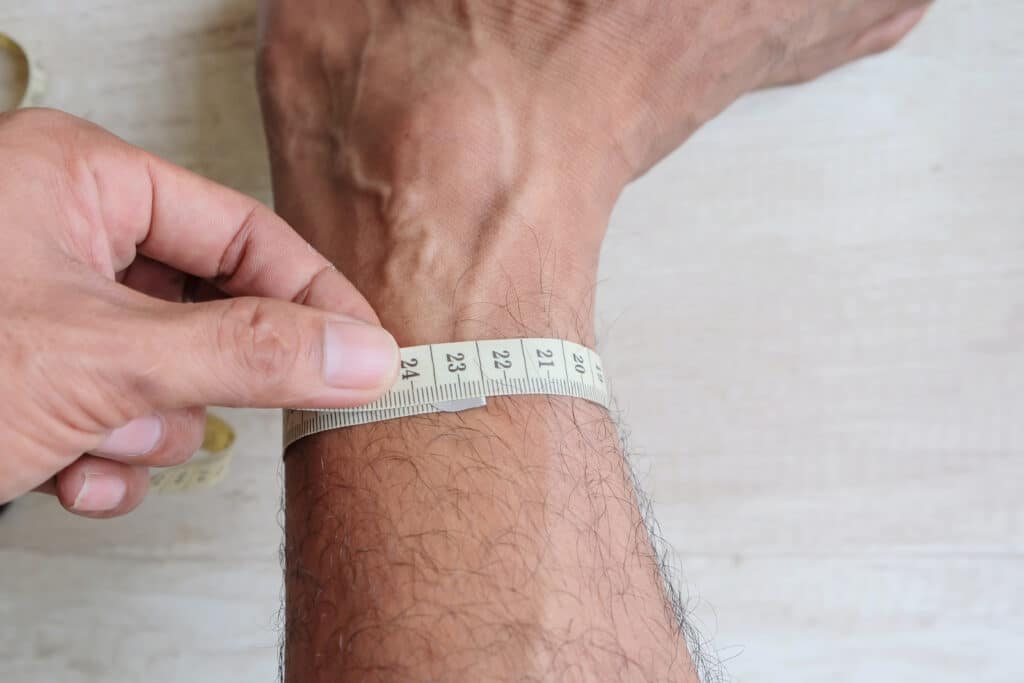
Calf circumference is measured by placing a tape measure around the widest part of your calf:
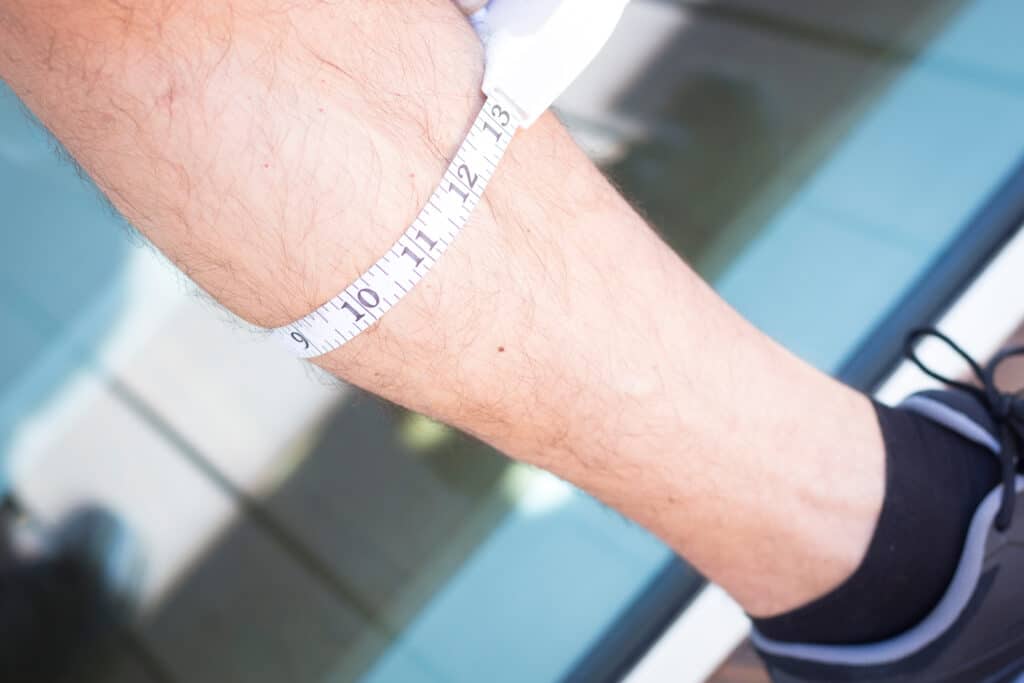
Leg length is measured by running a tape measure from the bend in your knee to the floor:
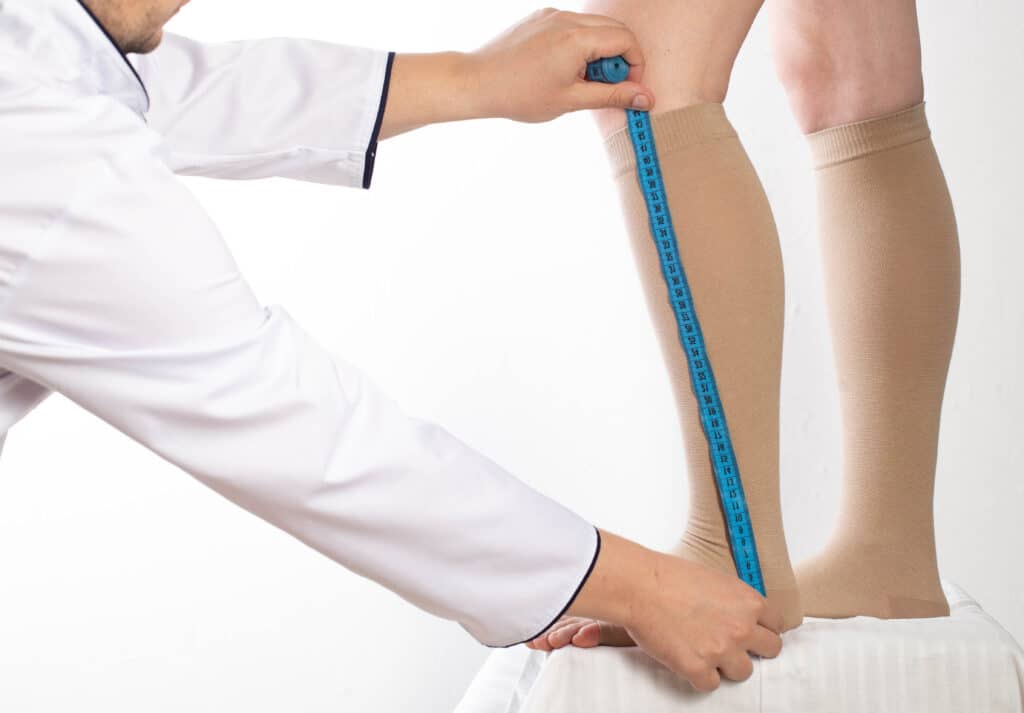
Getting The Right Pressure For Your Needs
Generally speaking, the proper pressure for compression socks depends on your needs and any medical conditions. Here’s a quick outline of the pressure measurements for specific situations.
- For non-medical uses and casual wear—such as jobs that require extensive standing— 15-20 mmHg is often recommended for light support and reducing leg swelling.
- For sportswear and lowering the risk of blood clotting during inactivity, 20-30 mmHg is recommended in most cases.
- For medical uses, 30-40 mmHg or even up to 60 mmHg may be used under the supervision of your doctor.
- For pregnant women, recommendations range anywhere from 10-20mmHg, but it is best to discuss with your doctor before use.
Remember that these pressures depend on the accurate fitting of your compression socks. This means that getting the correct measurement can make or break the value of your socks, so make sure to check with your healthcare provider for help with getting measurements.
Style and Color Choices
Once you’ve determined the right size and type of compression socks, it’s time to consider style and color. The purpose and occasion of wearing the socks can influence your choice.
For instance, if you’ll be wearing them for work, you might prefer knee-high socks in a neutral color. If you’re choosing socks for exercise, consider an open-toe style for greater flexibility.
When it comes to color, it’s all about personal preference and your comfort level. Options range from standard black, white, and beige to more vibrant patterns and colors. The variety of styles and colors shows how many people use them, so you can choose socks that match your personality and medical needs.
Wearing Your Compression Socks Correctly
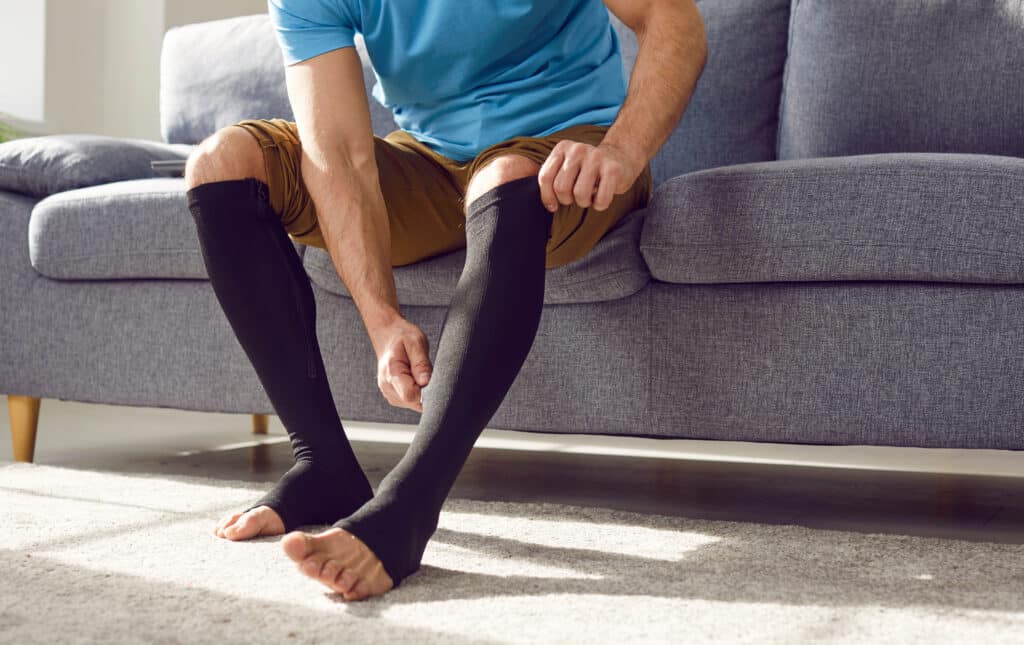
Compression socks aren’t as uncomfortable as you might think.
The first step to wearing these socks is prepping your legs. A little lotion or baby powder can make the process smoother, helping the sock slide on more comfortably.
Putting Your Socks On
Take your compression sock and turn it inside out up to the heel.
Place your foot inside the sock, ensuring your heel is squarely in the sock’s heel pocket. Gradually pull the sock up your leg, smoothing any wrinkles. Try to avoid rolling or folding the top of the sock down. Doing so can cause discomfort and reduce the sock’s effectiveness.
If you find it challenging to pull the socks up, a stocking donner device can be a game changer. These devices are designed to help you with this exact issue, making the process easier and less strenuous.
Removing Your Compression Socks the Right Way
Removing your socks should be done carefully when your long day is over.
Start by gently rolling the sock down from top to bottom, carefully avoiding pulling or tugging on the fabric.
Once the sock is off, turn it right side out.
Washing your hands after handling the socks is a good practice to avoid dirt or bacteria contamination.
Caring for Your Compression Socks
Caring for your compression socks is as vital as wearing them correctly. Regular washing keeps them clean, fresh, and effective. Following the manufacturer’s instructions for washing and drying the socks is paramount. This could involve using mild soap and water, hand washing, machine washing in a mesh bag, and air drying or tumble drying on low heat.
Remember to replace your compression socks every 3 to 6 months or when they show signs of wear and tear. These signs could be holes, fraying, or a noticeable loss of elasticity.
You’re investing in your health and comfort by properly wearing and caring for your compression socks. They’re more than just socks—they’re a tool for better leg health and worth the extra care.
Summary
Compression socks are a critical tool for managing circulation issues, offering significant benefits for individuals, particularly older adults dealing with poor circulation, swelling, and the risk of blood clots. These specialized socks enhance blood flow and ease discomfort. They are applicable not only for various medical conditions such as venous insufficiency, deep vein thrombosis, and diabetic neuropathy but also for lifestyle situations like prolonged sitting, standing, and athletic activities. The selection process of compression socks involves choosing the correct type, size, and pressure level according to the individual’s specific needs and medical conditions, highlighting the importance of consulting with healthcare providers. Proper usage, including how to wear and care for these socks, ensures their effectiveness and longevity, making them more than just a piece of clothing but a significant investment in one’s health and well-being.
Key Takeaways
Here are some of the most essential points to remember about compression socks:
- Compression socks are specialized garments designed to enhance blood flow from the legs to the heart, effectively reducing swelling and discomfort, particularly for older adults experiencing poor circulation.
- These socks offer multiple benefits, including reducing swelling, preventing blood clots like deep vein thrombosis (DVT), and alleviating varicose or spider vein pain.
- They are useful for various conditions, including venous insufficiency, lymphedema, orthostatic hypotension, and diabetic neuropathy.
- Compression socks also have applications in everyday life, proving beneficial for individuals with jobs requiring prolonged sitting or standing, athletes, pregnant women, and those in postpartum recovery.
- Selecting the correct type, size, and pressure level of compression socks is crucial, depending on individual needs and medical conditions. Choices include graduated, anti-embolism, or non-medical support hosiery.
- Proper use and care of compression socks are essential for maintaining their effectiveness and longevity. This includes correct methods for wearing, removing, and washing the socks to ensure they continue to provide the desired benefits.
- Compression socks can be integrated into daily routines with a range of styles and colors available, underscoring the importance of consulting with healthcare providers to determine the best option for one’s health and wellness regimen.
References
- Compression Stockings. Medline Plus.
- Kearon C, Akl EA, Ornelas J, et al. Antithrombotic Therapy for VTE Disease: CHEST Guideline and Expert Panel Report [published correction appears in Chest. 2016 Oct;150(4):988]. Chest. 2016;149(2):315-352. doi:10.1016/j.chest.2015.11.026
- Dahm KT, Myrhaug HT, Strømme H, Fure B, Brurberg KG. Effects of preventive use of compression stockings for elderly with chronic venous insufficiency and swollen legs: a systematic review and meta-analysis. BMC Geriatr. 2019 Mar 7;19(1):76. doi: 10.1186/s12877-019-1087-1. PMID: 30845919; PMCID: PMC6407277.
- Rabe E, Partsch H, Hafner J, Lattimer C, Mosti G, Neumann M, Urbanek T, Huebner M, Gaillard S, Carpentier P. Indications for medical compression stockings in venous and lymphatic disorders: An evidence-based consensus statement. Phlebology. 2018 Apr;33(3):163-184. doi: 10.1177/0268355516689631. Epub 2017 Feb 22. PMID: 28549402; PMCID: PMC5846867.
- Protheroe CL, Dikareva A, Menon C, Claydon VE. Are compression stockings an effective treatment for orthostatic presyncope? PLoS One. 2011;6(12):e28193. doi: 10.1371/journal.pone.0028193. Epub 2011 Dec 16. PMID: 22194814; PMCID: PMC3241624.
- Lim CS, Davies AH. Graduated compression stockings. CMAJ. 2014 Jul 8;186(10):E391-8. doi: 10.1503/cmaj.131281. Epub 2014 Mar 3. PMID: 24591279; PMCID: PMC4081237.

